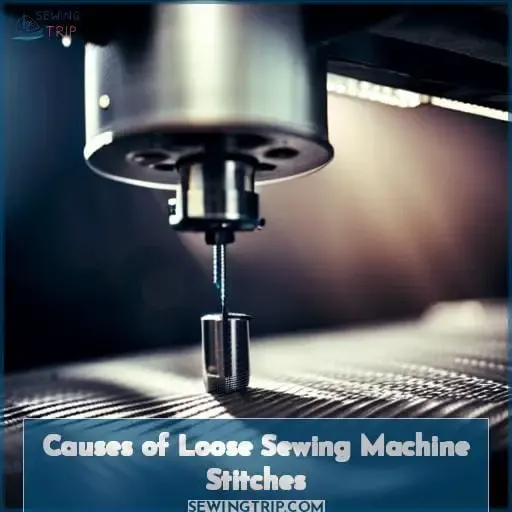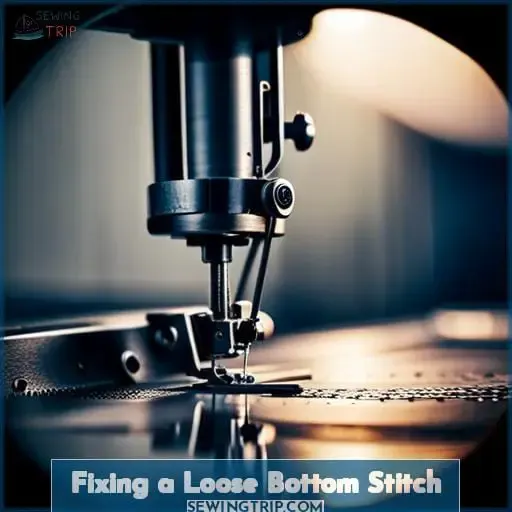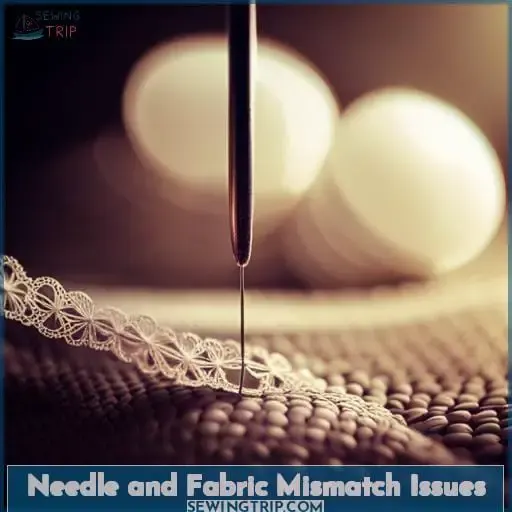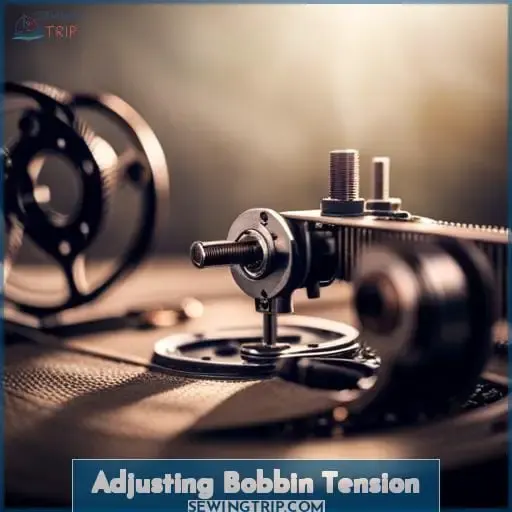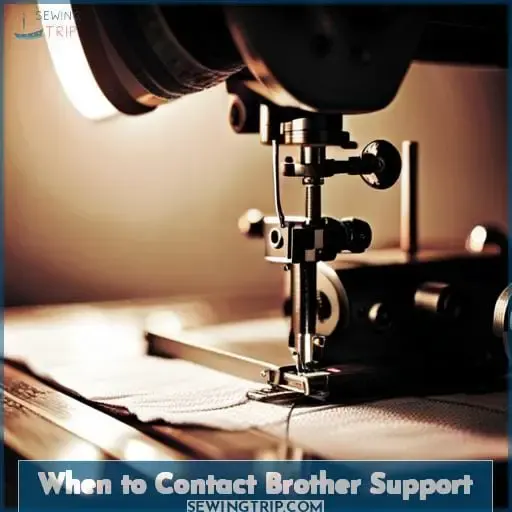This site is supported by our readers. We may earn a commission, at no cost to you, if you purchase through links.
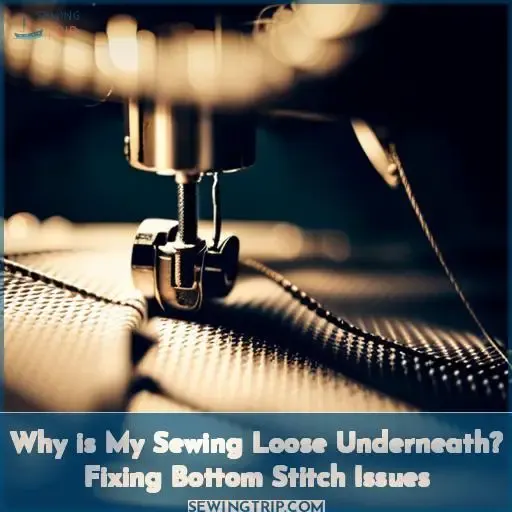 If you’re a sewing enthusiast, you’ve probably encountered loose sewing underneath your fabric.
If you’re a sewing enthusiast, you’ve probably encountered loose sewing underneath your fabric.
You can quickly resolve this issue with a few adjustments to your sewing machine and a keen eye for detail.
Let’s dive into the reasons why your sewing is loose underneath and how to fix it, so you can get back to creating beautiful, durable projects.
Table Of Contents
Key Takeaways
- Check upper thread tension setting and threading path from spool to needle for issues
- Ensure even and proper bobbin winding and insertion; inspect for debris or damage
- Use the correct needle type and size to match the fabric being sewn
- Clean any lint buildup in bobbin area; bent spring can affect tension
Causes of Loose Sewing Machine Stitches
Let’s troubleshoot why your sewing is loose on the bottom side.
This can happen when:
- The machine is threaded incorrectly
- The upper thread tension needs adjusting
- The bobbin isn’t inserted or wound right
- You’re using the wrong needle
Machine is Improperly Threaded
Improper threading of your machine leads to loose bottom stitches if you fail to thread the upper thread and bobbin through the correct paths and tension disks.
Be sure to follow the manual and diagrams, raising the presser foot and needle to the highest position before re-threading completely.
Pay special attention to threading the upper thread properly through the tension disks, take-up lever, and needle eye from top to bottom.
Similarly, place the bobbin in the case so it unwinds counterclockwise, then draw the thread through the tension spring correctly.
Mis-threaded paths prevent proper tension adjustment no matter how you set the dials.
Upper Thread Tension Issue
An improper upper thread tension setting can also cause loose bottom stitches.
If the tension discs don’t apply enough tension to the upper threading, stitches can come out loose, especially on the underside.
Carefully check your machine’s tension dial and adjust to the recommended setting for your fabric type and thread size.
You may need to test on scrap material first before sewing your project, to get the tension balanced perfectly.
Proper threading techniques and selecting the right size needle will also help resolve a loose bottom stitch caused by upper thread issues.
Bobbin Inserted or Wound Incorrectly
You’re stitching could be loose underneath if your bobbin’s been put in or wound incorrectly.
- Check that the bobbin is seated fully into the bobbin case.
- Inspect the bobbin winding to ensure even, smooth winding.
- Verify thread alignment through the tension spring on the bobbin case.
- Examine direction of bobbin winding and unwinding.
Incorrect Sewing Needle
Another common cause of loose bottom stitches is selecting the wrong needle for the fabric you’re sewing.
Using a needle that’s too large or small for your fabric affects stitch precision and can lead to skipped stitches, seam puckering, and overall inaccurate stitching.
Always match your thread and needle to the weight and type of fabric for neat, even stitches and quality results.
The correct needle optimizes stitch length and prevents looseness on the bottom side.
Fixing a Loose Bottom Stitch
Is your sewing coming out loose and looped on the underside?
Before rethreading the machine, first check that the upper thread tension is correctly balanced. Also, take a minute to clean any lint or debris from tension disks and bobbin areas.
If the thread and needles seem compatible with the fabric, try switching to a larger needle before replacing damaged ones.
Now focus your attention on potential bobbin issues—ensure it’s wound smoothly and inserted properly into the bobbin case.
Finally, confirm the upper threading path is correct and the thread is secured in tension disks.
With attention to these areas, you’ll likely resolve an infuriatingly loose bottom stitch.
Check Upper Thread Tension
Once you’ve verified the upper thread tension is set correctly, test stitch on scrap fabric and adjust if needed until the tension is balanced.
- Check threading path from spool to needle.
- Inspect tension discs for debris.
- Try a heavier needle.
- Replace damaged needles.
Clean and Inspect Machine Parts
You should clean and inspect your machine parts.
Check for any lint buildup or debris that could interfere with proper threading and tension.
Carefully wipe down key areas and make sure components like tension discs are free of obstruction.
Verify alignment of parts and mechanisms.
Test components to ensure smooth operation after inspecting and cleaning.
Lubricate as needed per manual.
Removing debris helps prevent jams and ensures proper tension.
Try a Larger Needle if Necessary
If your needle-and-thread mismatch persists, try a larger needle to fix your loose bottom stitches.
Here are 3 tips:
- Use a larger needle size like 14/90 for heavier fabrics. This creates a bigger hole for thicker threads.
- Choose needle sizes 11/80 to 16/100 for general sewing on medium wovens. Go up a size if skipping stitches.
- Refer to your manual’s fabric/needle chart. Match the needle size to the fabric weight for best results.
Replace Damaged Needles
One damaged needle should immediately be replaced when fixing a loose bottom stitch issue.
An old needle can develop burrs, hooks, or wear that distorts the stitch forming process.
Always examine needles closely and replace bent, blunted, or damaged ones.
Using fresh needles helps maintain fabric compatibility and aids in overall sewing machine troubleshooting.
Upper Thread Tension Problems
After replacing any damaged needles, check if your upper thread tension is causing the loose bottom stitching.
Look at the tension dial and try adjusting it following your sewing machine manual’s guidelines.
Make small turns between 4-5 settings.
Test on scrap fabric before sewing your project.
An improper thread path or wrongly wound spool can also impact tension, so trace the path and check your threading.
With a little troubleshooting, you’ll get your top thread tension balanced for neat seams.
Bobbin Winding/Insertion Problems
Your bobbin placement and winding may be at fault if you have a loose bottom stitch.
Ensure your bobbin is wound evenly and inserted properly into the bobbin case.
The bobbin should spin clockwise when unwinding.
Use the correct bobbin for your machine.
Check for lint buildup under the bobbin case.
A damaged or bent spring can affect bobbin tension too.
Proper bobbin maintenance prevents loose stitches.
Needle and Fabric Mismatch Issues
You’ll run into issues if you use the wrong needle for your fabric. Matching your needle to your fabric prevents skipped stitches and thread breaks.
Thick fabrics like denim require a sharp needle to pierce the material. Choose a denim needle for heavyweight fabrics.
Ballpoint and stretch needles glide between knit fabric instead of piercing it. They prevent gnarled seams on stretchy material.
For silks and sheers, use a fine microtex needle.
When your needle and fabric are compatible, you’ll achieve the perfect stitch tension and quality.
Take needle selection seriously for flawless results on any fabric.
Choosing the proper needle prevents tension troubles and stitch imperfections.
Adjusting Bobbin Tension
Let’s take a moment to inspect the bobbin tension. This is key to preventing loose bottom stitches.
Start by removing the bobbin case and verifying the bobbin tension screw is set properly.
Make small quarter-turn adjustments in either direction while test sewing on scrap material.
The goal is a balanced stitch with no puckering on the bottom or top.
You may need to tighten the screw for thinner threads or loosen slightly for thicker specialty threads.
Remember to recheck tension whenever you switch threads.
Staying on top of bobbin maintenance and tension adjustments ensures your machine sews smooth, even stitches on the bottom and top on any fabric.
When to Contact Brother Support
If you’ve tried all the troubleshooting steps and your sewing machine’s stitches are still loose underneath, contact Brother customer support for further assistance.
Their team of experts can provide tailored solutions not found in general DIY guides.
Chat online or call Brother’s customer service when you’ve exhausted home remedies.
For common issues like tension and threading, keep trying fixes yourself first.
But for persistent loose stitches without obvious causes, take advantage of Brother’s online help and friendly, knowledgeable staff.
With the right support, you’ll be back to smooth sewing quickly.
Frequently Asked Questions (FAQs)
What tension setting should I use for quilting cotton fabric?
For quilting cotton, start with an upper tension setting around 4 and a lower tension that allows the bobbin thread to just barely show on the right side of the fabric.
Test on scraps first and adjust in increments as needed until balanced stitches form.
The goal is smooth sewing without looseness or puckering.
How do I know if my presser foot pressure is set correctly?
Check your test swatch.
If the top thread shows on the bottom or the stitches seem uneven, loosen the pressure.
Tighten slightly if skipped stitches occur.
The goal is smooth fabric feed and balanced tension between top and bobbin threads.
I’m using quality thread but my stitches are still loose, what should I check?
Verify the top and bobbin tensions are balanced.
If needed, adjust the top tension tighter.
Inspect the needle, replacing it if bent or damaged.
Check the bobbin case tension, tightening the screw if needed.
Finally, make sure the presser foot pressure is set firmly against the fabric.
How do I clean under the throat plate or feed dogs?
Carefully lift the throat plate to access the feed dogs.
Gently brush debris away with a small brush.
Take a tiny vacuum attachment to thoroughly clean around and under the dogs.
Be mindful not to damage any components.
Proper cleaning promotes smooth fabric feeding.
My sewing machine is making a clunking sound, what should I do?
Check under the needle plate for any obstructions getting caught in the machinery.
Also, inspect the motor belt for proper tension or signs of wear.
If issues persist, refer to your sewing machine‘s manual or contact a repair technician for service.
Conclusion
My darling, I know those loose stitches have been vexing you so! But fret not – like a slipped hem or missing button, this too can be mended.
We’ve walked through each cause and solution, step-by-step.
Now you’ve got the know-how and gumption to nip those loose underside stitches for good.
So thread up, adjust tension, and carry on creating with confidence!
Together, we’ll have that sewing machine singing sweeter than a lark in no time.

